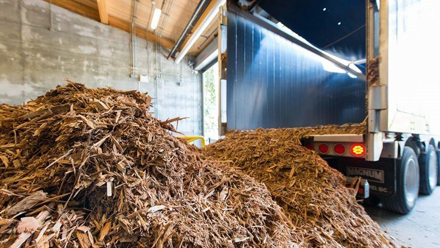
A 299-megawatt power station in the UK fuelled totally from timber residues is an example to Australia of the role that wood can play in the sustainable bioenergy economy, according to a new report. Tees Renewable Energy Plant is a biomass-fired combined heat and power plant that is under construction, says the report by KPMG for Bioenergy Australia. Source: Philip Hopkins for Timberbiz
It will cost about 650 pounds to build and will power about 600,000 homes. The power plant will consume 2.4 million tonnes of wood pellets and wood chips per annum sourced from sustainable forestry operations.
Tees qualifies for a subsidy under the UK’s contract for difference scheme, which supports large-scale renewable projects. The country has a renewable energy target of 15% by 2020.
The report also notes that in Switzerland, a biomass plant sourced from 220,000 tonnes of municipal waste produces steam and heat. A nearby paper mill, which uses large amounts of steam, uses the biomass plant to lower its carbon dioxide levels.
The KPMG study, ‘Bioenergy State of the Nation Report’, is a report on Australia’s bioenergy performance. It says in Australia, biomass makes up about 4% of energy consumption, whereas in the European Union, it is 10% and is set for massive growth.
Amongst OECD and International Energy Agency countries in 2016, Australia produced less than 10 gigajoules of bioenergy per capita, placing it in the bottom third of countries.
“Within the EU, energy from biomass contributes over 60% of primary renewable energy production,” the report says, helping to meet energy security challenges and reducing greenhouse gas emissions.
“We note Australia has less demand for heating than European countries, and a greater range of energy supply options, and this could therefore contribute to lower levels of bioenergy use on a per gigajoule (GJ) basis.”
Nevertheless, the Clean Energy Finance Corporation estimates a potential investment of $3.5 billion and $5 billion in energy from urban waste, agricultural waste and forest residues in Australia, the report says.
Bioenergy is generated by converting solid and liquid biomass into dispatchable electricity, heat, gas, liquid fuels and bio-based products.
Biomass feedstock – waste from wood, agriculture, industry and organic municipal waste and animal residues – is converted to products through technologies such as combustion, anaerobic digestion and gasification.
Biomass electricity can be produced through co-firing – the combustion of biomass with fossil fuels, such as in coal-fired generators.
The report says that in 2017, biomass made up only 1.4% of Australia’s total energy production. However, electricity is the main form of bioenergy in Australia, accounting for 92% of output, followed by biofuel at 5% and biochemical at 1%.
“We note that wood pellets are produced in Australia and exported to produce electricity in overseas markets,” says the report.
“Co-firing of solid biomass, such as wood pellets, has become common in Europe and Asia. Co-firing is relatively low cost compared to a new power station, and emissions of an existing coal-fired plant can be reduced.”
The report emphasises that bioenergy, if sustainably produced, is a renewable and carbon-neutral form of energy.
While it releases CO2 in the production process, “living biomass, such as wood residue from forests takes in carbon as it grows, offsetting the carbon that is released when it is converted into energy”.
“This results in a carbon-neutral cycle that does not increase the atmospheric concentration of greenhouse gases,” the report says.
KPMG identifies 222 operating bioenergy plants in Australia, of which 165 produce electricity. Of these, 40 generate more than five MW and 62 generate between one to five MW.
There are 14 projects that produce bio-products (fuel, wood pellets) for export. Of Australia’s bioenergy projects, wood waste makes up 33% of feedstock in Tasmania. In the other states, it is WA (14%), Qld (6%), NSW (2%), Victoria (17%) and SA (10%).
The report emphasises that a government plan and vision is crucial for the bioenergy sector to grow. It lists various policy levers to make this happen. They range from a bioenergy target or mandate to feed-in tariffs, capital grants, soft loans and guarantees and fuel-tax exemptions.
The report can be accessed on www.bioenergyaustralia.org.au





